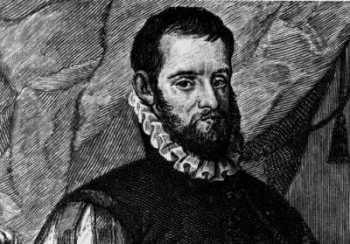September 17
Saint’s Day for Roberto Belarmino. Day of Melilla
1111 - Highest Galician nobility led by Pedro Froilaz de Traba and the bishop Diego Gelmírez crown Alfonso VII as "King of Galicia".

Pedro Menéndez de Avilés - photo web.aldeeu.org
1776 - The Presidio of San Francisco is founded in New Spain.
2012 - Esperanza Aguirre resigns in Madrid from the Assembly which she presided and her seat also.
Births:
1580 - Francisco de Quevedo, writer and poet was born in Villanueva de los Infantes, Ciudad Real.
1584 - Francisco Correa de Arauxo, composer (d. 1654)

The official wedding took place on 2 November 1701. Philip V was deeply in love with his wife from the start: as would be the case of his next consort, he was sexually dependent on her because his religious scruples prevented him from exercising any sexual life outside of marriage. Unlike what was normal for a Spanish monarch, he usually slept in her bed the entire night, and insisted upon his conjugal rights. Already shortly after their marriage, the French ambassador, the Duke of Gramont reported to Louis XIV that Philip would be completely governed by his spouse as long as he had one, a report that led Louis XIV to warn his grandson not to allow his Queen to dominate him.
In general, the young Queen's influence was beneficial: Maria Luisa Gabriella is described as remarkably mature for her age, politically savvy, articulate and hardworking. She was praised throughout Spain for her regency and had been credited with giving the normally passive Philip V the energy he needed to participate in warfare
In 1702, Phillip V was obliged to leave Spain to fight in Naples as part of the ongoing War of Spanish Succession. During her husband's absence, 14-year-old Maria Luisa Gabriella effectively acted as regent from Madrid, insisting upon all complaints being investigated, ordering that the reports were directly sent to her, and working for hours with ministers. She gave audiences to ambassadors and tried to prevent Savoy from joining the enemy, though this goal soon failed. However, her issues successfully encouraged the reorganization of the Junta and considerable monetary donations from several nobles and cities towards the war effort. Philip V was eventually recognised as King of Spain and retained most of its colonial possessions, but ceded territories in Italy and renounced the French throne for himself and his descendants.
French Courtier Marie Anne de La Trémoille, Princesse des Ursins, was a member of the Spanish Queen's household. She would maintain great influence over Maria Luisa Gabriella as her Camarera mayor de Palacio, the chief lady-in-waiting of the Queen's household. Trémoille maintained strong dominance in Spain by using all the rights of proximity to the Queen Regent that her position entitled her to: she was almost constantly in Maria Luisa Gabriella's presence, accompanied her wherever she went as soon as she left her private rooms, followed her to the council meetings where she listened sitting by the side sewing, followed her back to her rooms where she was present at the most intimate personal tasks, dressing and undressing her, and controlling whoever wished to come into her presence. As Philip V actually shared a bedroom with Maria Luisa Gabriella, the Princess came to obtain enormous influence over the King. In 1704, Trémoille was exiled at the order of King Louis XIV, devastating the rulers. However, in 1705, the Princess returned to Madrid, much to the Queen's joy
1838 - Valeriano Weyler, military and politician
1949 - Miguel Ángel Gómez Martínez, composer and orchestra conductor.
1956 - Francesc Capdevila "Max" comics cartoonist, illustrator and Spanish publisher.
1958 - Nancho Novo, actor.
1969 - Tito Vilanova, footballer and manager (d. 2014)
1975 - Álvaro Fuentes Ibarz, bass guitarist with the group ‘La Oreja de Van Gogh', was born in Guecho, Vizcaya province.
1977 - Juan Antonio Flecha, cyclist.
1978 - Cristina Alcázar, actress.
Deaths
1485 - Pedro Arbués, priest (b. 1441)
1574 - Pedro Menéndez de Avilés, Spanish admiral and explorer, founded St. Augustine, Florida (b. 1519)
1630 - Ranuccio II Farnese, Duke of Parma (d. 1694)
1665 - King Felipe IV whose reign saw the decline of Spain as a world power, of Spain and Portugal (1621-55) died aged 60. (b, 1605)
1674 - Pedro Menendez de Aviles,admiral and explorer, founded St Augustine, Florida (b. 1519)
1679 - John of Austria the Younger, general and politician, Governor of the Habsburg Netherlands (b. 1629)
1791 - Tomás de Iriarte, poet
1867 - Luis de Usoz, hebraísta and scholar (b. 1807)
1965 - Alejandro Casona, poet and playwright (b. 1903)
2001 - Rodrigo Uría González, lawyer, Prince of Asturias Award 1990.
2007 - Miguel Ramón Izquierdo, politician (b. 1919)
2011 - Ignacio Fernández de Castro, sociologist and lawyer (b. 1919)
